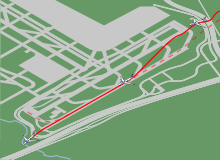 The wreckage of Flight 358, which crashed during landing after the aircraft burned out. | |
| Accident | |
|---|---|
| Date | 2 August 2005 |
| Summary | Crashed following runway excursion |
| Site | Toronto Pearson International Airport, Ontario, Canada 43°39′23.2″N 79°37′29.0″W / 43.656444°N 79.624722°W |
| Aircraft | |
| Aircraft type | Airbus A340-313E |
| Operator | Air France |
| IATA flight No. | AF358 |
| ICAO flight No. | AFR358 |
| Call sign | AIRFRANS 358 |
| Registration | F-GLZQ[1] |
| Flight origin | Charles de Gaulle Airport Paris, France |
| Destination | Toronto Pearson International Airport, Mississauga, Ontario, Canada |
| Occupants | 309 |
| Passengers | 297 |
| Crew | 12 |
| Fatalities | 0 |
| Injuries | 43 (31 minor, 12 serious) |
| Survivors | 309 |

Air France Flight 358 was a regularly scheduled international flight from Charles de Gaulle Airport in Paris, France, to Toronto Pearson International Airport in Ontario, Canada. On the afternoon of 2 August 2005, while landing at Pearson airport, the Airbus A340-313E operating the route overran the runway and crashed into nearby Etobicoke Creek, approximately 300 m (980 ft) beyond the end of the runway. All 309 passengers and crew on board the Airbus survived, but twelve people sustained serious injuries. The accident highlighted the vital role played by highly trained flight attendants during an emergency.
Due to inclement weather, 540 flights departing and arriving at Pearson were cancelled. Many small and mid-sized aircraft due to arrive were diverted to other Canadian airports in Ottawa, Hamilton, and Winnipeg. Most of the larger aircraft were diverted to Montreal,[2] Syracuse, New York,[3] and Buffalo, New York. Flights from Vancouver were turned back. The crash of Air France Flight 358 was the biggest crisis to hit Toronto Pearson since the airport's involvement in Operation Yellow Ribbon.
Jean Lapierre, the Canadian Minister of Transport, referred to Flight 358 as a "miracle" because everyone on board survived, despite the aircraft's complete destruction.[4] Other press sources described the accident as the "Miracle in Toronto",[4][5] the "Toronto Miracle,"[6] the " 'Miracle' Escape,"[7] and the "Miracle of Runway 24L."[8]
The accident was investigated by the Transportation Safety Board of Canada (TSB), with a final report issued on 13 December 2007. The unfavourable weather conditions, and the poor landing decisions made by the flight crew, were found to be major factors leading to the crash. The visibility was poor, the assigned runway was short (the airport's shortest), the plane touched down nearly halfway through the runway and the thrust reversers were not on full power until 17 seconds after touchdown.
- ^ "ASN Aircraft accident Airbus A340-313X F-GLZQ Toronto-Pearson International Airport, ON (YYZ)". aviation-safety.net.
- ^ "Toronto Star article". Toronto Star. Archived from the original on 29 September 2007. Retrieved 8 January 2017.
- ^ Grant, Carmen (3 August 2005). "Plane makes emergency landing". News 10 Now. Archived from the original on 3 March 2007. Retrieved 7 June 2011.
- ^ a b Cite error: The named reference
WeThoughtBlowSydwas invoked but never defined (see the help page). - ^ "Air France Crash in Canada; Discovery to Perform Repairs; National Identification Cards". Paula Zahn Now. CNN. 2 August 2005. Retrieved 15 January 2017.
- ^ "Passengers, Crew Survive Fiery Plane Crash," Fox News
- ^ "For crash survivors, a 'miracle' escape." Associated Press. 25 August 2005. Retrieved on 3 December 2009.
- ^ Cite error: The named reference
AvoidablePearsonwas invoked but never defined (see the help page).